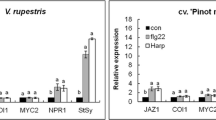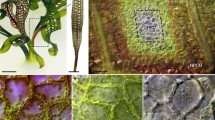Abstract
Grapevine (Vitis vinifera L., cv. Limberger) leaf tissues and suspension-cultured cells were induced to undergo programmed cell death (PCD) by exogenously added methyl jasmonate (MeJA). The elicitor signaling pathway involved in MeJA-induced PCD was further investigated using pharmacological, biochemical and histological approaches. Pharmacological dissection of the early events preceding the execution of MeJA-triggered PCD indicated that this process strongly depends on both, de novo protein and mRNA synthesis. Treatment of leaf discs and cell suspensions with lipase inhibitor Ebelactone B and specific lipoxygenase inhibitor Phenidone blocked MeJA-induced PCD. These results suggest that some chloroplast membrane-derived compound(s) is required for MeJA-induced PCD in grapevine. The progression of MeJAtriggered PCD may be further inhibited by the use of metabolic inhibitors of key enzymes of octadecanoid biosynthesis including AOS, AOC, and OPR indicating that the functional jasmonate biosynthetic pathway is an integral part of the MeJA-induced signal transduction cascade that results in the coordinate expression of events leading to PCD. Finally, the activation of the octadecanoid pathway, as a critical point in MeJA-induced PCD, was independently demonstrated with cellulysin, a macromolecular elicitor acting via octadecanoid signaling. The cellulysin was shown to be a very potent enhancer of MeJA-triggered PCD in grapevine cells.
Similar content being viewed by others
Abbreviations
- AOC:
-
allene oxide cyclase
- AOS:
-
allene oxide synthase
- CHX:
-
cycloheximide
- COR:
-
cordycepin
- DIECA:
-
diethyldithiocarbamic acid
- HR:
-
hypersensitive response
- JA:
-
jasmonic acid
- LOX:
-
lipoxygenase
- MeJA:
-
methyljasmonate
- NIA:
-
necrosis-inducing activity
- OPDA:
-
12-oxophytodienoic acid
- OPR:
-
12-oxophytodienoic acid reductase
- qRT-PCR:
-
quantitative real-time polymerase chain reaction
- TMV:
-
tobacco mosaic virus
- TUB:
-
tubulin
References
Avanci N., Luche D., Goldman G.H. & Goldman M.H. 2010. Jasmonates are phytohormones with multiple functions, including plant defense and reproduction. Genet. Mol. Res. 9: 484–505.
Bell E., Creelman R. A. & Mullet J. E. 1995. A chloroplast lipoxygenase is required for wound-induced jasmonic acid accumulation in Arabidopsis. Proc. Natl. Acad. Sci. USA 92: 8675–8679.
Chen Y., Pang Q., Dai S., Wang Y., Chen S. & Yan, X. 2011. Proteomic identification of differentially expressed proteins in Arabidopsis in response to methyl jasmonate. J. Plant Physiol. 168: 995–1008.
Chini A., Fonseca S., Fernandez G., Chico J.M. & Solano R. 2007. The JAZ family of repressors is the missing link in jasmonate signalling. Nature 448: 666–671.
Conconi A., Miquel M., Browse J. & Ryan C. A. 1996. Intracellular levels of free linolenic and linoleic acids increase in tomato leaves in response to wounding. Plant Physiol. 111: 797–803.
Dhondt S., Geoffroy P., Stelmach B. A., Legrand M. & Heitz T. 2000. Soluble phospholipase A2 activity is induced before oxylipin accumulation in tobacco mosaic virus-infected tobacco leaves and is contributed by patatin-like enzymes. Plant J. 23: 431–440.
Ellinger D., Sting N., Kubigsteltig I.I., Bals T., Juenger M., Pollmann S., Berger S., Schuenemann D. & Mueller M.J. 2010. DONGLE and DEFECTIVE IN ANTHER DEHISCENCE1 lipases are not essential for wound- and pathogen-induced jasmonate biosynthesis: redundant lipases contribute to jasmonate formation. Plant Physiol. 153: 114–127.
Feys B.J.F., Benedetti C.E., Penfold C.N. & Turner J.G. 1994. Arabidopsis mutants selected for resistance to the phytotoxin coronatine are male-sterile, insensitive to methyl JA, and resistant to a bacterial pathogen. Plant Cell 6: 751–759.
Gfeller A., Liechti R. & Farmer E. E. 2010. Arabidposis jasmonate signaling pathway. Sci. Signal. 3: 109–116.
Halitschke R. & Baldwin I.T. 2003. Antisense LOX expression increases herbivore performance by decreasing defense responses and inhibiting growth-related transcriptional reorganization in Nicotiana attenuata. Plant J. 36: 794–807.
Hyun Y., Choi S., Hwang H.J., Yu J., Nam S. J., Ko J., Park J.Y., Seo Y.S., Kim E.Y. & Ryu S.B. 2008. Cooperation and functional diversification of two closely related galactolipase genes for jasmonic acid (JA) biosynthesis. Dev. Cell 14: 183–192.
Ishiguro S., Kawai-Oda A., Nishida I. & Okada K. 2001. The defective in anther dehiscence1 gene encodes a novel phospolipase A1 catalyzing the initial step of jasmonic acid biosynthesis, which synchronizes pollen maturation, anther dehiscence, and flower opening in Arabidopsis. Plant Cell 13: 2191–2209.
Ismail A., Riemann M. & Nick P. 2012. The jasmonate pathway mediates salt tolerance in grapevines. J. Exp. Bot. 36: 1–13.
Kramell R., Miersch O., Atzorn R., Parthier B. & Wasternack C. 2000. Octadecanoid-derived alteration of gene expression and the ”oxylipin signature” in stressed barley leaves. Implications for different signaling pathways. Plant Physiol. 123: 177–188.
Lorenzo O., Chico J.M., Sanchez-Serrano J.J. & Solano R. 2004. JA-INSENSITIVE1 encodes a MYC transcription factor essential to discriminate between different JA-regulated defense responses in Arabidopsis. Plant Cell 16: 1938–1950.
Mueller M.J., Brodschelm W., Spannagl E. & Zenk M. 1993. Signaling in the elicitation process is mediated through the octadecanoid pathway leading to jasmonic acid. Proc. Nat. Acad. Sci. USA, 90: 7490–7494.
Narvaez-Vasquez J., Florin-Christensen J. & Ryan C.A. 1999. Positional specificity of a phospholipase A2 activity induced by wounding, systemin, and oligosaccharide elicitors in tomato leaves. Plant Cell 11: 2249–2260.
Piel J., Atzorn R., Gäbler R., Kühnemann F. & Boland W. 1997. Cellulysin from the plant parasitic fungus Trichoderma viride elicits volatile biosynthesis in higher plants via the octadecanoid signalling cascade. FEBS Letters 416: 143–148.
Repka V. 2002. Hydrogen peroxide generated via octadecanoid signaling pathway is neither necessary nor sufficient for methyl jasmonate-induced hypersensitive cell death. Biol. Plant. 45: 105–115.
Repka V. 2008. Grapevine (Vitis vinifera L.) microRNA expression profiling with miRNA bioarrays: indications for an involvement of miRNA in apoptosis and pathogenesis. Bulletin de L’OIV 81: 171–178.
Repka V. & Fischerová I. 2001. New findings to the role of tunikamycin in grapevine: disease defense response. Vitis 40: 169–174.
Repka V., Kubíková J. & Fischerová I. 2000. Immunodetection of PR-1-like proteins in grapevine leaves infected with Oidium tuckerii and in elicited suspension cell cultures. Vitis 39: 123–127.
Repka V., Fischerová I. & Šilhárová K. 2001. Methyl jasmonate induces a hypersensitive-like response of grapevine in the absence of avirulent pathogens. Vitis 40: 5–10.
Repka V., Fischerová I. & Šilhárová K. 2004. Methyl jasmonate is a potent elicitor of multiple defense responses in grapevine leaves and cell.spuspension cultures. Biol. Plant. 48: 273–283.
Robson F., Okamoto H., Patrick E., Harris S.R., Wasternack C., Brearley C. & Turner J.G. 2010. Jasmonate and phytochrome A signaling in Arabidopsis wound and shade responses are integrated through JAZ1 stability. Plant Cell 22: 1143–1160.
Royo J., Leon J., Vancanneyt G., Albar J. P., Rosahl S., Ortego F., Castanera P. & Sanchez-Serrano J. 1999. Antisensemediated depletion of a potato lipoxygenase reduces wound induction of proteinase inhibitors and increases weight gain of insect pests. Proc. Nat. Acad. Sci. USA, 96: 1146–1151.
Schäfer M., Fischer C., Meldau S., Seebald E., Oelmüller R. & Baldwin I.T. 2011. Lipase activity in insect oral secretions mediates defense responses in Arabidopsis thaliana. Plant Physiol. 156: 487–496.
Schaller A. & Stintzi A. 2009. Enzymes in jasmonate biosynthesis — structure, function, regulation. Phytochemistry 70: 1532–1538.
Schaller F., Schaller A. & Stintzi A. F. 2005. Biosynthesis and metabolism of jasmonates. J. Plant Growth Regul. 23: 179–199.
Schlink K. 2011. Gene expression profiling in wounded and systemic leaves of Fagus sylvatica reveals up-regulation of ethylene and jasmonic acid signalling. Plant Biol (Stuttg). 13: 445–452.
Seeley K. A., Byrne D. H. & Colbert J.T. 1992. Red lightindependent instability of oat phytochrome mRNA in vivo. Plant Cell 4: 29–38.
Sheard L.B., Tan X., Mao H., Withers J., Ben-Nissan G., Hinds T.R., Kobayashi Y., Hsu F.F., Sharon M., Browse J., He S.Y., Rizo J., Howe G.A. & Zheng N. 2010. Jasmonate perception by inositol-phosphate-potentiated COI1-JAZ coreceptor. Nature 468: 400–405.
Stintzi A. & Browse J. 2000. The Arabidopsis male-sterile mutant, opr3, lacks the 12-oxo-phytodienoic acid reductase required for jasmonate synthesis. Proc. Nat. Acad. Sci. USA, 97: 10625–10630.
Vanholme B., Grunewald W., Bateman A., Kohchi T. & Gheysen G. 2007. The tify family previously known as ZIM. Trends Plant Sci. 12: 239–244.
Vick B. A. & Zimmerman D. C. 1984. Biosynthesis of jasmonic acid by several plant species. Plant Physiol. 75: 458–461.
Weber H. 2002. Fatty acid-derived signals in plants. Trends Plant Sci. 7: 217–224.
Weber H., Vick B. A. & Farmer E.E. 1997. Dinor-oxo-phytodienoic acid: a new hexadecanoid signal in the jasmonate family. Proc. Natl. Acad. Sci. USA, 94: 10473–10478.
Yan J., Zhang C., Gu M., Bai Z., Zhang W., Qi T., Cheng Z., Peng W., Luo H., Nan F., Wang Z. & Xie D. 2009. The Arabidopsis CORONATINE INSENSITIVE1 protein is a jasmonate receptor. Plant Cell 21: 2220–2236.
Zhang Y. & Turner J.G. 2008. Wound-induced endogenous Jas stunt plant growth by inhibiting mitosis. PLoS One 3: e3699.
Zhu Q., Chappell J., Hendricks S. A. & Lamb C. 1995. Accurate in vitro transcription from cicrularized plasmid templates by plant whole cell extracts. Plant J. 7: 1021–1030.
Author information
Authors and Affiliations
Corresponding author
Rights and permissions
About this article
Cite this article
Repka, V., Čarná, M. & Pavlovkin, J. Methyl jasmonate-induced cell death in grapevine requires both lipoxygenase activity and functional octadecanoid biosynthetic pathway. Biologia 68, 896–903 (2013). https://doi.org/10.2478/s11756-013-0220-4
Received:
Accepted:
Published:
Issue Date:
DOI: https://doi.org/10.2478/s11756-013-0220-4




